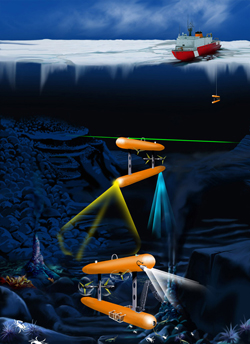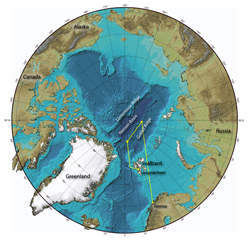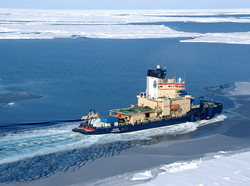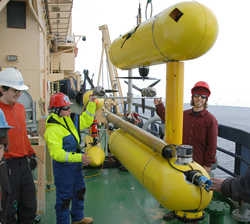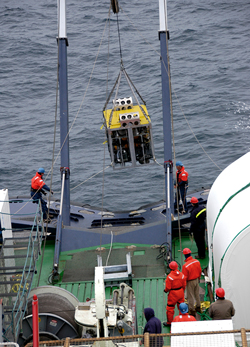WHOI researchers have built two new autonomous underwater vehicles (AUVs) and a new tethered, remote controlled sampling system specifically for the difficult challenges of operations in the Arctic ice. They hope to discover exotic seafloor life and submarine hot springs in a region of the ocean that has been mostly cut off from other ecosystems for at least 26 million years.
The 30-member research team will depart on July 1 from Svalbard for a rare
expedition to study the Gakkel Ridge, the extension of the mid-ocean ridge
system which separates the North American tectonic plate from the Eurasian
plate beneath the Arctic Ocean. The 40-day cruise on the Oden—a 108-meter (354-foot) long icebreaker operated by the Swedish Maritime Administration—will take researchers close to the geographic North Pole.
The research team for the Arctic Gakkel Vents Expedition
(AGAVE) includes specialists in each field of deep-sea exploration, with
scientists and engineers from the United States,
Germany, Japan, Norway, and Sweden. WHOI geophysicist Robert Reves-Sohn will serve as chief scientist. Fellow principal investigators include: Tim Shank, a hydrothermal vent biologist from WHOI; Hanumant Singh, a WHOI engineer and vehicle developer; marine chemist Henrietta Edmonds of the University of Texas at Austin, who sailed on the last research expedition to the Gakkel Ridge in 2001; Susan Humphris, a WHOI geochemist who has surveyed dozens of hydrothermal vent sites around the world; and Peter Winsor, a WHOI oceanographer who studies Arctic currents and their implications for climate.
Major funding for the expedition and for vehicle development was provided by the National Science Foundation (NSF) and the National Aeronautics and Space Administration (NASA).
“This is an exciting opportunity to explore and study a portion of Earth’s surface that has been largely inaccessible to science,” said Reves-Sohn. “Any biological habitats at hydrothermal vent fields along the Gakkel Ridge have likely evolved in isolation for tens of millions of years. We may have the opportunity to lay eyes on completely new life forms that have been living in the abyss beneath the Arctic ice pack.”
Most of the instrumentation that researchers would normally use to study deep sea environments and organisms—such as the human occupied submersible Alvin or tethered vehicles—cannot be safely operated in the Arctic ice, which can easily crush most small vehicles. So researchers asked Singh and colleagues to design and develop three new vehicles from scratch.
During the July expedition, researchers will use the Puma AUV, or “plume mapper,” to sniff
out the chemical and temperature signals of hot, mineral-rich fluids venting
out of the ocean floor. Once Puma finds
the source of venting, Singh and colleagues will send down the Jaguar AUV, which will use cameras and
bottom-mapping sonar systems to image the seafloor. Finally, the “Camper” towed
vehicle will be lowered to the seafloor to scoop or vacuum up rocks, sediments,
and living creatures. (Click here to view an MP4 animation of the sequence.)
During a 10-day engineering trial in May and June 2007, all three vehicles were lowered through the Arctic ice and driven underwater, while engineers simultaneously tested acoustic communications techniques. The researchers were able to recover their vehicles from beneath the ice, which can be risky in the midst of moving floes that can quickly close the leads around an icebreaker.
“Anyone can deploy an AUV in the Arctic; the trick is getting it back,” said Singh, who will send his vehicles to the seafloor for 10 to 24 hours during the Gakkel expedition. “The trick is getting it back. In order to have a good day with an autonomous vehicle, the number of recoveries must equal the number of launches.”
The Gakkel Ridge extends roughly 1,800 kilometers (1,100 miles) from north of Greenland toward Siberia. It is both the deepest ocean ridge—ranging from 3 to 5 kilometers (1.8 to 3 miles) beneath the ice cap—and the slowest spreading tectonic plate boundary anywhere on Earth. The ridge moves roughly one centimeter (1/3 inch) per year, about 20 times slower than most other ridges.
At most mid-ocean ridges, Earth’s crust spreads apart,
allowing hot magma from the mantle to come up and form new ocean crust. The
enormous heat sparks chemical reactions between crustal rocks and the seawater
that seeps down into them. These chemical reactions produce hot, mineral-rich fluids that spew like geysers from seafloor vents, as well as massive deposits of minerals, such as copper and zinc. These hydrothermal fluids also contain chemicals that sustain rich communities of unusual life forms, which thrive via chemosynthesis, rather than photosynthesis.
Many geologists believed the Gakkel Ridge region would be too geologically cold to produce hydrothermal vents. And yet during a 2001 expedition, researchers found signs of such venting in the Arctic. Where there are vents, there may be unusual seafloor life forms.
“A few years ago, mid-ocean ridge and hydrothermal vent
biologists came together and asked: ‘Where are the key places in the world to
go to make big leaps in understanding biodiversity?’ The Gakkel Ridge was one
of the top places,” said Shank, who plans to study the genetics of animals
found during the expedition. “The region has been mostly separated from the Atlantic and Pacific oceans for millions of years, so whatever lives there has since been evolving in relative isolation—much the way animals in Australia did," Shank added. "We know that deep-sea Arctic fauna found away from vents are more than 70 percent different from all others around the world. So at hydrothermal vents we are likely to find completely new suites of species with never-before seen adaptations.”
Some scientists—including program managers and scientists from the NASA Astrobiology Program—have been keenly interested in the possibility that Gakkel Ridge may harbor life forms and environmental conditions consistent with primordial Earth or other watery planets.
“The origin of life discussion comes up because the rocks that are exposed on this very slow spreading ridge are not volcanic, but instead come directly from Earth’s mantle,” said Humphris. “The chemistry is very much like the volcanism that occurred on the primordial Earth. If you are thinking about origins of life, you’d like to have an area that is the closest analog to what was happening on the early Earth.”
In July 2001, WHOI researchers were part of the Arctic
Mid-Ocean Ridge Expedition (AMORE) that produced the first detailed maps of the
Gakkel Ridge and made the unexpected discovery that the ridge is volcanically
active. Scientists recently also found that large sections of Earth’s mantle are
deposited directly onto the seafloor along the Gakkel Ridge.
The Gakkel Ridge expedition will be covered live on the web, allowing students, educators, and the general public to follow along with daily dispatches from the Arctic Ocean. The Dive and Discover web site (www.divediscover.whoi.edu) brings students and teachers along on research field trips to read about science in action, while the Polar Discovery project (polardiscovery.whoi.edu) uses photos and live phone calls from the Oden to allow museum visitors and the public to see the Arctic through the eyes of the explorers.
Support for the Gakkel Ridge expedition and for underwater vehicle development has been provided by the National Science Foundation’s Office of Polar Programs and Division of Ocean Sciences; the NASA Astrobiology Program; the WHOI Deep Ocean Exploration Institute; and the Gordon Center for Subsurface Sensing and Imaging Systems, an NSF Engineering Research Center.
The Woods Hole Oceanographic Institution is a private, independent organization in Falmouth, Mass., dedicated to marine research, engineering, and higher education. Established in 1930 on a recommendation from the National Academy of Sciences, its primary mission is to understand the oceans and their interaction with the Earth as a whole, and to communicate a basic understanding of the ocean's role in the changing global environment.
Last updated: October 26, 2010 | |||||||||||||
Copyright ©2007 Woods Hole Oceanographic Institution, All Rights Reserved, Privacy Policy. | |||||||||||||
